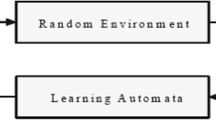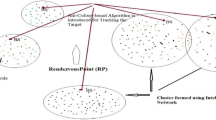Abstract
Wireless sensor networks, a new generation of networks, are composed of a large numbers of nodes and the communication between nodes takes place wirelessly. The main purpose of these networks is collecting information about the environment surrounding the network sensors. The sensors collect and send the required information. There are many challenges and research areas concerned in the literature, one of which is power consumption in network nodes. Nodes in these networks have limited energy sources and generally consume more energy in long communication distances and therefore run out of battery very fast. This results in inefficacy in the whole system. One of the proposed solutions is data aggregation in wireless networks which leads to improved performance. Therefore, in this study an approach based on learning automata is proposed to achieve data aggregation which leads to dynamic network at any hypothetical region. This approach specifies a cluster head in the network and nodes send their data to the cluster head and the cluster head sends the information to the main receiver. Also each node can change its sensing rate using learning automata. Simulation results show that the proposed method increases the lifetime of the network and more nodes will be alive.












Similar content being viewed by others
References
Yick, J., Mukherjee, B., & Ghosal, D. (2008). Wireless sensor network survey. Computer Networks, 52(12), 2292–2330.
Nakamura, E. F., Loureiro, A. A., & Frery, A. C. (2007). Information fusion for wireless sensor networks: Methods, models, and classifications. ACM Computing Surveys (CSUR), 39(3), 9.
Younis, O., Krunz, M., & Ramasubramanian, S. (2006). Node clustering in wireless sensor networks: Recent developments and deployment challenges. IEEE Network, 20(3), 20–25.
Abbasi, A. A., & Younis, M. (2007). A survey on clustering algorithms for wireless sensor networks. Computer Communications, 30(14–15), 2826–2841.
Li, F., & Wang, Y. (2008). Circular sailing routing for wireless networks. In INFOCOM 2008. The 27th conference on computer communications. IEEE (pp. 1346–1354). New York: IEEE.
Casari, P., Nati, M., Petrioli, C., & Zorzi, M. (2006). ALBA: An adaptive load-balanced algorithm for geographic forwarding in wireless sensor networks. In Military communications conference, 2006. MILCOM 2006. IEEE (pp. 1–9). New York: IEEE.
Yi, Y., Kwon, T. J., & Gerla, M. (2001). A load aware routing (LWR) based on local information. In 2001 12th IEEE international symposium on personal, indoor and mobile radio communications (Vol. 2, p. G). New York: IEEE.
Yang, J., Lin, Y., Xiong, W., & Xu, B. (2009). Ant colony-based multi-path routing algorithm for wireless sensor networks. In 2009. ISA 2009. International workshop on intelligent systems and applications (pp. 1–4). New York: IEEE.
Sarigiannidis, A. G., Nicopolitidis, P., Papadimitriou, G. I., Sarigiannidis, P. G., Louta, M. D., & Pomportsis, A. S. (2015). On the use of learning automata in tuning the channel split ratio of WiMAX networks. IEEE Systems Journal, 9(3), 651–663.
Dehkordi, S. S., & Torkestani, J. (2014). Channel assignment scheme based on learning automata for clustered wireless ad-hoc networks. Journal of Computer Science and Information Technology, 2, 149–172.
Beheshtifard, Z., & Meybodi, M. R. (2014). Online channel assignment in multi-radio wireless mesh networks using learning automata. Preprint. arXiv:1405.3448.
Kashanaki, M., Beheshti, Z., & Meybodi, M. R. (2012). A distributed learning automata based gateway load balancing algorithm in wireless mesh networks. In 2012 International symposium on instrumentation and measurement, sensor network and automation (IMSNA) (Vol. 1, pp. 90–94). New York: IEEE.
Sarigiannidis, A., Nicopolitidis, P., Papadimitriou, G., Sarigiannidis, P., & Louta, M. (2011). Using learning automata for adaptively adjusting the downlink-to-uplink ratio in IEEE 802.16 e wireless networks. In 2011 IEEE symposium on computers and communications (ISCC) (pp. 353–358). New York: IEEE.
Heinzelman, W. B., Chandrakasan, A. P., & Balakrishnan, H. (2002). An application-specific protocol architecture for wireless microsensor networks. IEEE Transactions on Wireless Communications, 1(4), 660–670.
Junping, H., Yuhui, J., & Liang, D. (2008). A time-based cluster-head selection algorithm for LEACH. In IEEE symposium on computers and communications, 2008. ISCC 2008 (pp. 1172–1176). New York: IEEE.
Manjeshwar, A., & Agrawal, D. P. (2001). TEEN: A routing protocol for enhanced efficiency in wireless sensor networks. In Null (p. 30189a). New York: IEEE.
Younis, O., & Fahmy, S. (2004). HEED: A hybrid, energy-efficient, distributed clustering approach for ad hoc sensor networks. IEEE Transactions on Mobile Computing, 3(4), 366–379.
Lindsey, S., & Raghavendra, (2002). C. S. PEGASIS: Power-efficient gathering in sensor information systems. In Aerospace conference proceedings. IEEE (Vol. 3, p. 3). New York: IEEE.
Manjeshwar, A., & Agrawal, D. P. (2002). APTEEN: A hybrid protocol for efficient routing and comprehensive information retrieval in wireless sensor networks. In Ipdps (p. 0195b). New York: IEEE.
Zahmati, A. S., Abolhassani, B., Shirazi, A. A. B., & Bakhtiari, A. S. (2007). An energy-efficient protocol with static clustering for wireless sensor networks. International Journal of Electronics, Circuits and Systems, 1(2), 135–138.
Author information
Authors and Affiliations
Corresponding author
Additional information
Publisher's Note
Springer Nature remains neutral with regard to jurisdictional claims in published maps and institutional affiliations.
Electronic supplementary material
Below is the link to the electronic supplementary material.
Rights and permissions
About this article
Cite this article
Tamiji, M., Nasri, S. Data Aggregation for Increase Performance of Wireless Sensor Networks Using Learning Automata Approach. Wireless Pers Commun 108, 187–201 (2019). https://doi.org/10.1007/s11277-019-06395-x
Published:
Issue Date:
DOI: https://doi.org/10.1007/s11277-019-06395-x




